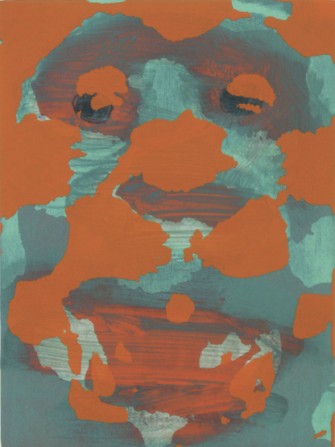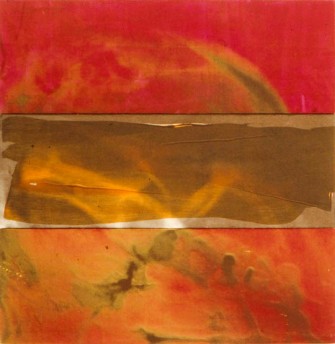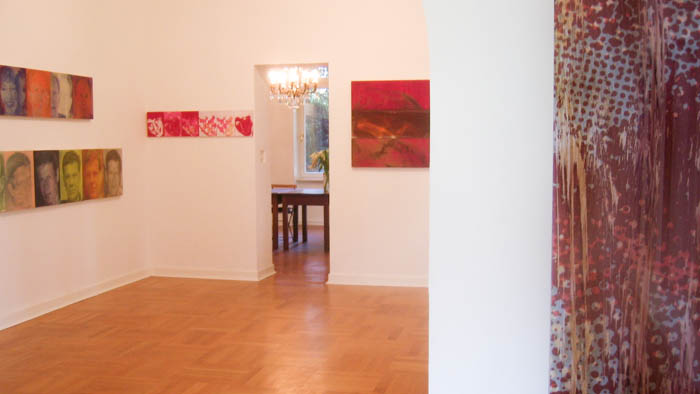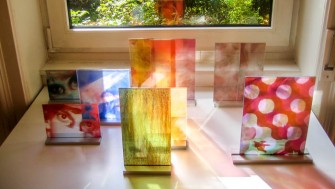– looking at –
Speech on the opening of exhibition on September 9th 2006 in the Galerie König, Hanau
Imagine you are visiting the monkey house at the zoo. A gorilla is sitting there in his cage and observing you with interest. Out of view for you and the gorilla, a keeper is approaching from the side with bananas in his hand. While you and the gorilla are still looking at each other, the gorilla will “see” the bananas before he notices the keeper.
A study involving experiments with apes showed that they are able to detect things as soon as their attention has been awakened even if these things lie out of their field of vision. These recent results of brain research are described as “a magnifying glass in the head”. This research is specifically concerned with how attention stimulates and strengthens the senses, especially the sense of sight.
Human beings, too, have this “magnifying glass in the head”, although we only consciously register a fraction of the visual information which falls on our retina. But if something catches our attention, this awareness of the senses focuses on this area. Even before the line of vision changes, the so-called mechanisms of attention-regulation cause a sharpening of our sense of sight – that is why, for example, we can recognize street signs at the edge of our field of vision.
Perhaps you are wondering why I’m telling you something about apes and their keenness of sight and what this could have to do with art in general and in particular with Bernd Fischer’s work?
Well – ideally art should stimulate our senses, should enable us to understand things we are not usually visually aware of. Bernd Fischer’s works do exactly that, in an emphatic and well-considered way.
Take a look, for example, at the small series of monkey pictures. Try to focus on just one picture. You’ll probably find it difficult to recognize the figurative motif. At the same time you will become increasingly aware of the variations of the pictures hanging next to it; all the images together combine to give us an idea of the figuration hidden in the paint.
 No title (150)
No title (150)
2006
printed and painted colour
plywood panel
26 x 19,5 cm
Bernd Fischer’s themes range from figurative renderings of literary and historical motives from the 80s to abstract colour compositions worked into X-ray motives, pictures with human organs and series of modulated portraits, up to his current colour compositions.
His techniques and the materials he works with are just as varied: painting, photography, screen-printing or sculptures – on canvas, paper, cardboard, wood and glass. The complexity is simultaneously a programme in painting design in which the multiple layers of paint intensify the use of space or layers of stapled glass create new perspectives.
The artist works on elementary questions of modern art: how can figuration are adequately transformed in contemporary art? How can three-dimensionalism be shown in a two-dimensional picture? These questions lead to others concerning the “recognition theory” of art and reality: what lies behind the visible, below the surface? This leads further to existential considerations such as how to make the essential human being visible in art.
The human being was and is the spiritual and figurative leitmotif which is to be found in most of Fischer’s work, sometimes concretely, sometimes almost completely dissolved into the abstract.
Bernd Fischer studied Design and Visual Communication at the Hochschule für Gestaltung in Offenbach. Parallel to this he studied sculpture at the Städel Art School in Frankfurt with Michael Croissant.
Heads, birds, the human being on asymmetrical backgrounds – the figure and its relationship to space – basic questions of sculpture – these remained Fischer’s main theme in painting too.
In the mid-80s his “astronaut pictures” appeared, inspired by the first live film pictures of free-floating men in space. These raster-screened television images seemed to Fischer to be the ideal metaphor for the contemporary human being. The astronaut in his high-tech suit robbed of his individuality, steps over the natural borders of human life to conquer new dimensions. The counterpart of these pictures are the image of the Miner of Falun inspired by a tale by ETA Hoffmann in which a man enters the inner regions of the earth and loses his way there. In both works, human beings in extreme spatial situations, in total isolation, and completely thrown back on their own resources are depicted through the confrontation of figuration and colour abstraction.
Here as later, Fischer is fascinated by hidden, inaccessible worlds. This leads him to the question of what lies hidden in the innermost regions of the human being. It is at the same time an attempt to find a contemporary visual representation for – as Fischer describes it – the IKON of the human being, a spiritual form, valid for our time, of representing the human being.
The Panel Painting
In my opinion, the X-ray pictures, which he started work on in the 1990s are especially characteristic for Bernd Fischer’s understanding of art. They are large, abstract paintings which are under laid with X-ray photographs. Fischer has discovered in them realistic and abstract forms of depicting the human being. X-ray photos, especially those of the skull, are usually immediately recognizable as those of human beings. At the same time they are free of any evaluation as to their gender, race, religion or social status. Even individual features are not recognizable for lay people. A skull X-ray photograph is a skull X-ray – but at the same time a lot more. It shows the vessel containing our brain, the source of our spirit and our perception. The special quality of the technique opens up a secretive, three-dimensional, quasi mythical-mystical space which usually remains hidden.
Bernd Fischer intensifies this significance (iconology) even more by his use of photographs of the Foramen Magnum, the opening at the base of the skull where the brain and the spinal cord meet and the body and spirit are joined.
At the same time the X-ray photographs stand for an invisible but nevertheless existing world. This concrete image is transferred to canvas by means of screen-printing and overlaid with paint.
Subjective choice of colour and individual malgestus lend the X-ray pictures their character and their emotional effect. Simultaneously they break up the figuration and the real context.
 Beyond the desert
Beyond the desert
1999
printed and painted colour
plywood panel
three parts, 84 x 81,5 cm
Privatly owned, Ursula König
Faced with a withdrawal of the immediate concrete relationship the viewer is forced to trace the form in the colour space; to allow himself to be drawn deeper into the picture, to sharpen his senses, to recognize what lies behind the painting. In connection with the motive, the subjective choice of colour and the individual gesture these pictures awaken a great variety of emotions, of cosmic associations, spherical colour fields and memories off illness or even death. At the same time they also connect with the tradition of the Vanitas motif. Like these, Fischer’s X-ray paintings make the viewer reflect about himself. They remind us of the transitory nature of life by confronting us with an ancient image – an ‘Eikon’.
In 1996, Bernd Fischer took up another challenge when he accepted his first commission for a portrait. More were to follow. Faithful to his maxims to make the invisible visible, the artist strives to portray the hidden characteristics of a person and not a mere likeness.
From the photos he forms the basic material for his pictures. By means of screen-printing in varying enlargements, solutions and colours, he makes layers on top of and next to each other on the surface. It is decisive that the person is shown through a series of modulations. In this way a portrait is created from many panels which have to be seen as a picture on its own.
Bernd Fischer’s self-portrait was created from eight variations of a photo; the six part double portrait of Mr. and Mrs. Thimm joins several different photographs of them. Through layering and above all by screen-rastering and painting over the photographic material, a different emotional impression can be evoked on each panel. The amalgamation produces a portrait of many facets of the portrayed person – an iconography, a concept used in antiquity to describe a collection of portrait paintings which showed one and the same person.
Screen-printing
is a decisive creative form. Stimulated by the television broadcast out of space, Bernd Fischer sought a form of painting which suited the rastered structure of the television pictures. He discovered this form in screen-printings as this shows the structure of the motif in the smallest paint dots, a kind of raster. The smaller the raster (the dots) are, the simpler it is to reconstruct picture; the larger the raster, the more difficult it is to recognize the picture. It is with this effect that Bernd Fischer works and has developed his specific painting technique – with the means of screen-printing and raster-screening.
That is, he uses the screen-printing technique first of all for an objective 1:1 transfer of the motif presentation on to the underground – without a subjective change by the individual style of the artist.
The realistic motif is produced in a second step in variously-sized raster screens by means of screen prints in subjectively selected colours which hare laid over the previously printed motif.
Repeatedly appearing motifs, such as the faces of young and old people, primates or radiological pictures of people and animals are worked on in this way in multiple variations in the panel paintings. Like a researcher, Bernd Fischer examines how our awareness of a motif is changed by changing colours and layering. In addition to this come manual techniques which give the effect of spontaneous and playful interventions by the artist and outline the forms of the basic motif or emphasize details for the viewer.
Glass
Bernd Fischer has also used glass as a basis for his paintings. Glass preserves that transparency which is an essential facet of X-ray photos and at the same time the colours become considerably more brilliant and lively through constantly changing light. Fischer’s glass paintings are also based on the virtuoso use of paint, raster-printing and screen-printing. Distributed over several glass-panes, every new colour form combinations are developed by means of shifting the transparent panels which reflect the possibilities of our spiritual associations.
The small glass works are composed of several parts and demonstrate a variable structure, emphasising their three-dimensional object-character either on the wall or standing freely. The motifs are similar to those of the panel pictures, but what there has to be printed or painted in layers, one over the other, can be painted on different panels, due to the transparency of the material. And so the work phases of the picture – quasi the aggregate condition of the motif – can be distributed on various glass panes and can either be drawn apart as single, separate pictures or can be drawn together over each other and regarded as one collective picture. At the same time a three-dimensional space is created through the layers of the panels. This is quite a different concept from the single larger-scale glass panels. They develop space through a complex layering of paint and extend their two-dimensionalism through the ever-changing reflection of the colours on the wall or the floor. In these more recent works of Bernd Fischer, the raster structure is now the artist’s only Painting instrument. Just as one can make large or small strokes with a brush, so can Bernd Fischer use large or small raster structures for his design and explores more deeply the relationship between the resulting dots and empty spaces.
Whether the actual original form and the raster dots are recognizable is now of little importance. On the contrary, the motif and its resulting partial character is alienated through the extreme enlargement.
In this connection, Bernd Fischer discovered that the maximisation of the raster-screen -one could imagine this as the zoom function on a digital camera – from a certain size on, no longer follows the lows of proportion. It can even happen that the raster takes on its own form and unpredictable alterations take place – the concrete form dissolves.
This spontaneous change of the actual connected order is taken up by Bernd Fischer and he consciously sets the structured form of his colour framework into a dynamic field of tension with a random organic pattern. This is created by the fact that Fischer sprays the over-printed paint (before it is burnt into the glass) with water, or brushes over it lightly with a wet paint brush. The water dissolves the dried glass paint, mixes the layers of paint by an osmotic effect and displaces the clear borders of the raster form. This procedure runs according to its own laws and the artist has only a limited amount of control. In short, the influence of water disturbs the structured order of the raster-screening.
Fischer’s painting methods are multiple and complex, they formally examine our perception and challenge our understanding. They awaken our attention and urge us to sharpen our view, to activate “the magnifying glass in our head”, to see what lies behind the obvious.
I wish you all on viewing the exhibition exciting discoveries and new stimuli for your senses. Practise developing your awareness and using your eyes. (S.R.)
Frankfurt. September 2006

